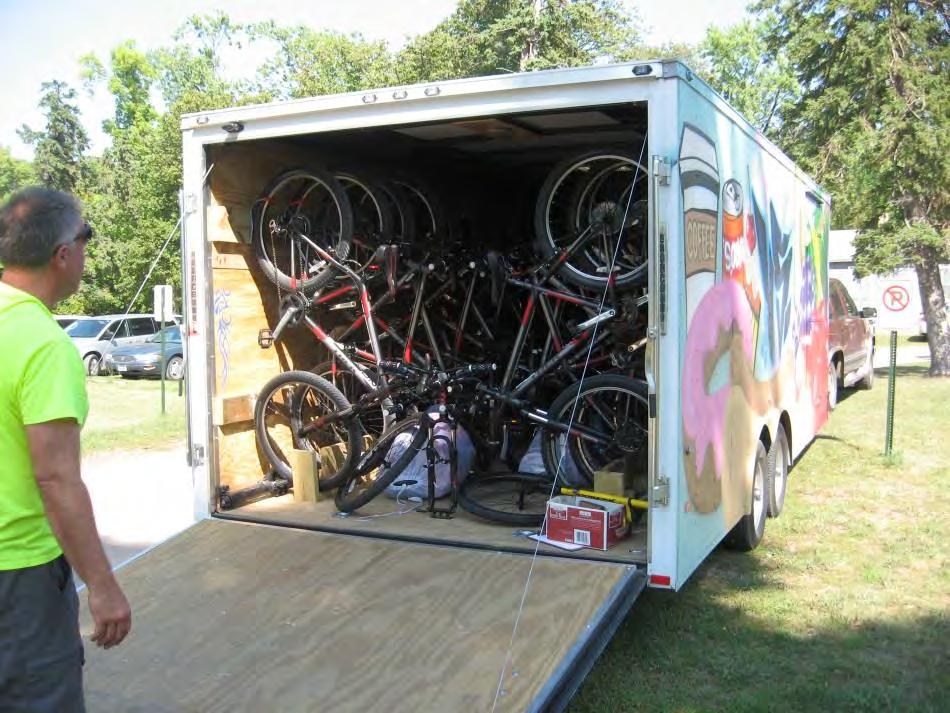
31 minute read
Action Plan Recommendations
A C TIO N PL AN R E CO MM E ND AT ION S
EDUCATION
Goal: Establish at least two educational programs a year within the community to teach and foster good bicycle and pedestrian safety habits.
1. Continue to facilitate an annual bicycle rodeo event to teach bicycle skills and safety to students.
Bicycle Rodeos are bicycle safety training events held over the period of several hours that teach bicycle safety lessons and on-bike skills, usually in a station format (e.g., bicycle safety check, helmet fitting, instruction about the rules of the road, on-bike obstacle course, on-bike skills drills, etc.). While geared towards children, many of the lessons can be appropriate for adults as well. Bicycles rodeos can be held as part of a larger event or on their own, and either during the school day or outside of school. Adult volunteers can administer rodeos, or they may be offered through the local police department. Key partners in implementing a bicycle rodeo event may (should) include teachers, League of American Bicyclists Cycling Instructors, and PartnerSHIP 4 Health.
2. Educate students about proper walking and bicycling etiquette through in-school and after-school bicycle and pedestrian safety education. a. If not existing, establish an after-school club. b. Utilize the Walk! Bike! Fun! curriculum to help students understand the rules of the road.
c. Identify the need for a bicycle fleet
Observation results indicate that a portion of students did not exhibit proper walking techniques. Students were not utilizing crosswalks and some were seen not looking for traffic when they were crossing the street. Some of the bicyclists also displayed improper techniques by riding through stop signs and even not looking before entering an intersection. Also, on June 2, 2008 at 19:40 hours, a 12-year-old male on a bicycle was struck by an automobile on Walker Avenue. It was determined that the 12-year-old male on a bicycle was at fault as he darted out into traffic and failed to yield the right-of-way to the driver of the automobile.
P a g e 10 | Executive Summary, Significant Findings And Action Plan
The Walk! Bike! Fun! curriculum is an in-classroom and real-world (on foot, on bike) educational resource and can help address improper walking and biking behaviors like that observed by the SRTS Team. Taught by specially-trained school district teachers, this curriculum is intended for children ages five through thirteen. It teaches life-long skills related to traffic rules, potential hazards, and bike handling skills that enable students to walk and bike safely and comfortably to and from school along with other trips around their communities. The curriculum addresses a variety of walking and bicycling topics and is endorsed by MnDOT. Finally, in order to engage students in the Walk! Bike! Fun! curriculum, the New York Mills School District should identify the need for a bicycle fleet, or identify a nearby fleet they may be able to borrow.
Figure 1: The Fergus Falls bike fleet is kept inside this towable trailer.
Executive Summary, Significant Findings And Action Plan | P a g e 11
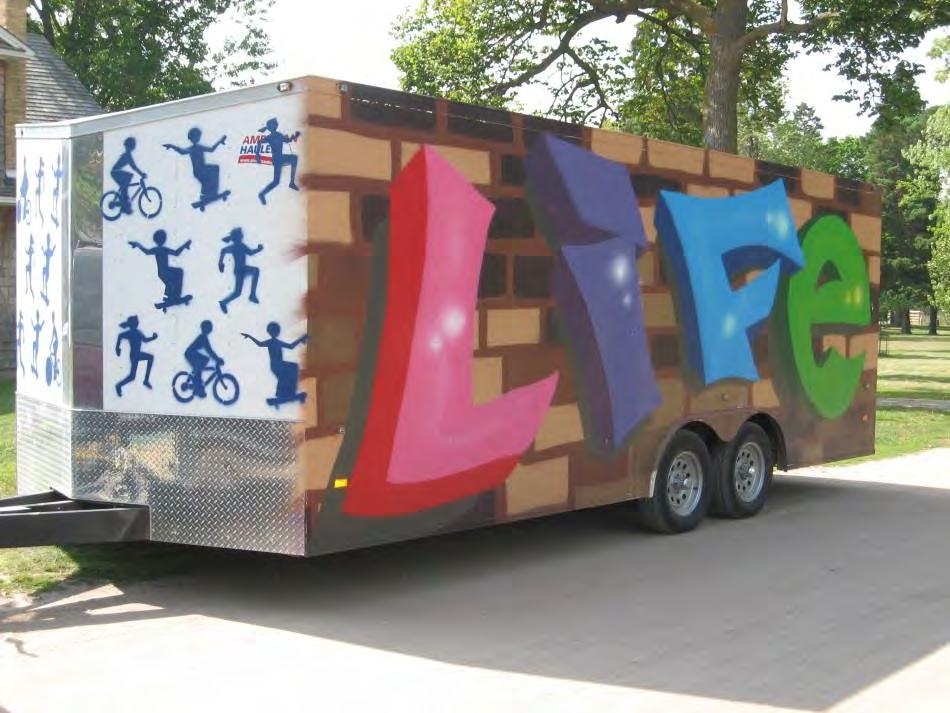
Figure 2: Some of the inspirational graphics painted onto the sides of the Fergus Fall s bike fleet trailer.
3. Look into developing a school district safety campaign to build awareness of students walking and bicycling to and from school, and to encourage safe driving behavior among parents, high school students and passersby. If the referenced resources in this plan do not provide the information desired, please feel free to contact the staff at WCI and
PartnerSHIP 4 Health for additional ideas.
While observations by the SRTS Team seem to indicate rather good driver behavior, casual observations made by the author while in the city in March 2016 and in comments from parents in the Parent Survey indicate that driver behavior near the school could be better. This is particularly true at dismissal time when teenage high school drivers depart in their private automobiles. Possibly backing up these concerns is a slight spike in the crash history during the 15:00 hour (3PM to 4PM). A school safety campaign should be developed that builds awareness around students walking and bicycling to and from school. An effective safety campaign might utilize multiple forms of media to get the attention of parents, students and passersby. Desired outcomes would be improved walking, bicycling and driver safety behaviors (particularly near the school), and youth empowerment.
P a g e 12 | Executive Summary, Significant Findings And Action Plan
4. Design a parent workshop to provide tools, resources and support needed to encourage parents and other community members to begin walking and bicycling for transportation.
If the referenced resources in this plan do not provide the information desired, please feel free to contact the staff at WCI and PartnerSHIP 4 Health for additional ideas.
A parent workshop for those living in and around New York Mills can provide the tools, resources and support needed for parents to overcome some of the common barriers noted by parents to not allow their children to walk or bicycle to and from school. While distance was the most notable barrier noted by parents, traffic speed and the amount of traffic were the 2nd and 3rd most noted barriers. While traffic is a real threat to student safety for those walking to school, it is something that can be mitigated to some degree through education and parent involvement. Topics such as how to be a responsible driver, starting a walking school bus, and launching a safety campaign may impact the amount and speed of traffic near the school route.
5. Create a family-oriented educational training program that builds upon the school safety campaign (#3) such as a family biking class and/or family biking guide to teach basic bicycle maintenance, safety checks, etc. If the referenced resources in this plan do not provide the information desired, please feel free to contact the staff at WCI and
PartnerSHIP 4 Health for additional ideas.
Educational trainings teach students the skills necessary to walk and bicycle safely while encouraging them to try walking and bicycling on a regular basis. If held in conjunction with the school safety campaign, students and families have the opportunity to prac tice skills and gain confidence.
6. Consider constructing the multi-use path in the redesigned / reconstructed Lund Park with
“traffic garden” features. Traffic gardens are common throughout Europe and are more often painted onto a playground surface. However, they can be elaborate and complex with completely functioning traffic lights, railroad gates, etc. The planned recreation pathway network could be constructed to have the basic elements of a traffic garden like stop signs, painted crosswalks, solid and dashed yellow centerlines, turn lanes and even a traffic circle to teach children proper traffic and safety behaviors associated with walking and biking.
Executive Summary, Significant Findings And Action Plan | P a g e 13
There are plans to reconstruct Lund Park that lies just to the north and east of the school. There was a desire to incorporate a SRTS transportation element into the proposed 5000 foot long asphalt trail. Unfortunately, even after exhaustive brainstorming, no SRTS transportation benefit could be found due to the park’s restricted location. However, there is no reason why the trail couldn’t be built with common traffic control devices found in New York Mills like traffic signs and striping.
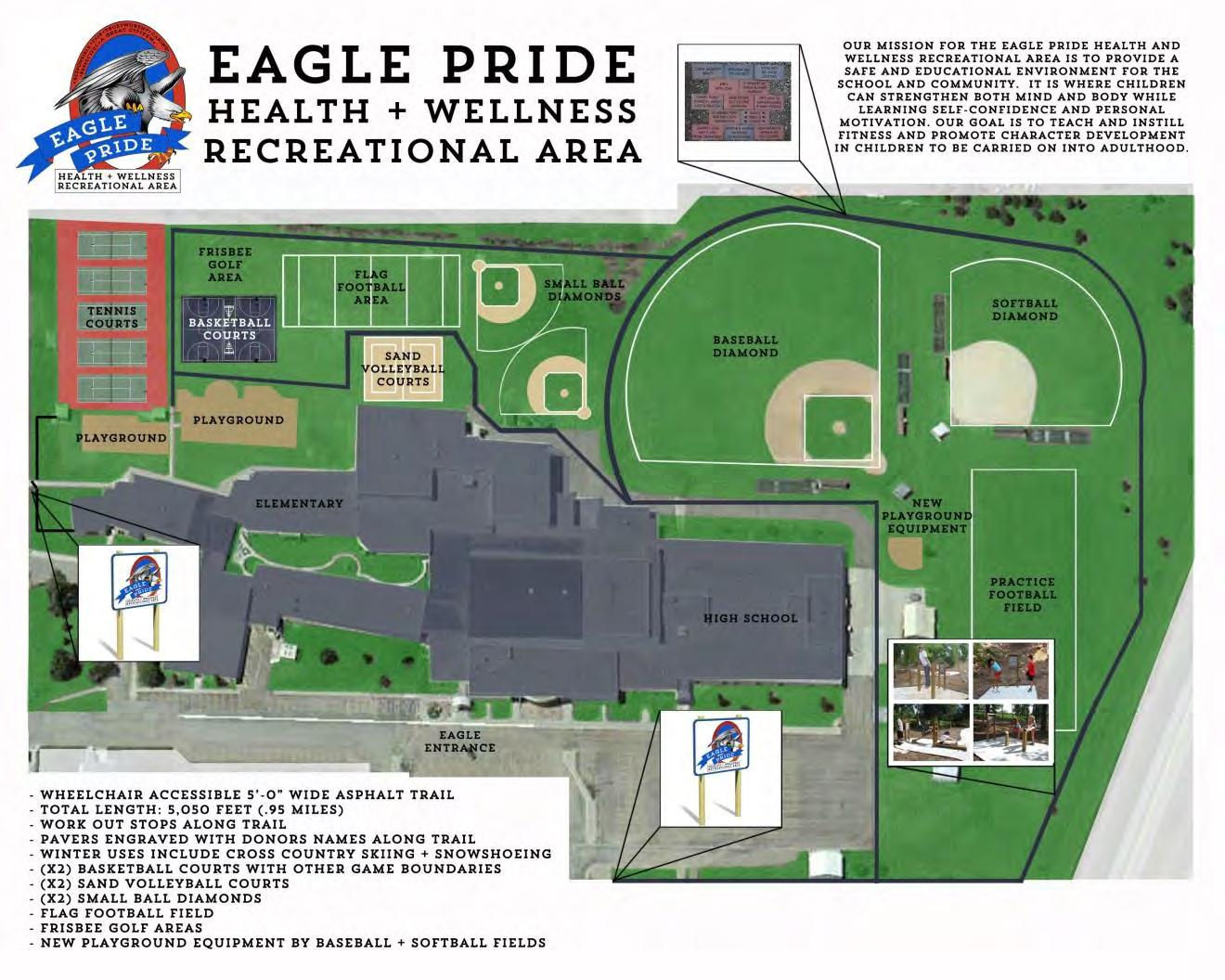
Figure 3: An early rendering of the proposed “Eagle Pride Health and Wellness Recreational Area.” The author of this report has already suggested that the trail be a minimum of eight feet wide to meet minimum AASHTO Bikeway standards.
P a g e 14 | Executive Summary, Significant Findings And Action Plan
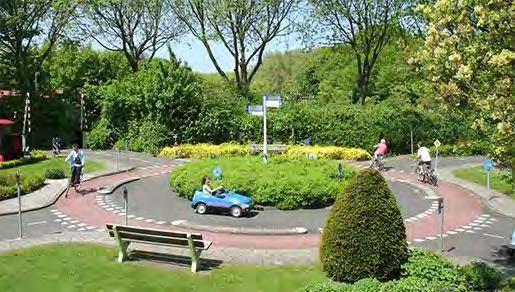
Figure 4: This is an example of an elaborate traffic garden from the city of Utrecht in the Netherlands. Basic, but still effective, traffic garden elements could be incorporated into the recreational pathway network being considered for Lund Park. (Photo courtesy of Clarence Eckerson Jr. and Elizabeth Press at Streetfilms)
For more Education ideas, see Minnesota SRTS Model Policies Tip Sheet (Appendix E) and the Minnesota SRTS Resource Center – Education:
http://www.dot.state.mn.us/mnsaferoutes/resources/education.html .
ENCOURAGEMENT
Goal: Explore strategies to promote walking and bicycling through the identification of safe routes, organizing events, rewarding participation, and educating adults.
1. A review of relevant New York Mills School District policies was performed as part of this
SRTS plan. The district should follow through on its policy for providing bicycle and pedestrian safety education in grade K through 5 and investigate updating its policy language with the goal of making it more encouraging of the goals and best practices of
SRTS. Amendments for the Wellness providing detailed SRTS guidance specific to
Minnesota was produced by the Public Health Law Center at the William Mitchell College of Law and can be found in Appendix D. It is suggested that the school district look to adopt these policies in whole or in parts. An additional policy resource specific to
Minnesota is the Minnesota SRTS Model Policies Tip Sheet which can be found in Appendix
Executive Summary, Significant Findings And Action Plan | P a g e 15
E. Furthermore, the SRTS National Partnership, in cooperation with ChangeLab Solutions (a multi-disciplinary, multi-government agency policy partnership), has developed an online SRTS District Policy Workbook. This resource is a comprehensive SRTS policy guide covering everything from general policies supporting SRTS to more advanced policies like “No Idling Policies” and “School Siting Policies.” This resource is best accessed on-line and
can be found at: http://www.changelabsolutions.org/safe-routes/welcome. Finally look for
possible improved policies coming out of the MnDOT SRTS Office and/or the Minnesota Department of Education in the near future.
Between the School District’s two Transportation Policies, (Appendices F and G), only the 709L Student Transportation Safety Policy (an 18-page document mostly dedicated to busing students) mentions anything about walking or biking to school. It states “The school district may provide student safety education for bicycling and pedestrian safety for students in grades K through 5,” and “Parents/Guardians are responsible to support safe riding and walking practices, and recognizes that students are responsible for their actions.” None of the other policies mention anything directly about bicycling, even though the term “riding” from the above-quoted policy could be interpreted to mean riding a bicycle but more likely refers to riding a bus.
The Wellness Policy is overall very supportive of the same goals generally pursued by SRTS and characterized by the statement “Students need opportunities for physical activity and to fully embrace regular physical activity as a personal behavior. Towards that end, physical education and health education will reinforce the knowledge and self-management skills needed to maintain a healthy lifestyle and reduce sedentary activities such as watching television.” It also states that “The New York Mills School District will encourage parents to support their children’s participation in physical activity.”
Overall the language in the three policies appears to be relatively standard as written by the Minnesota School Boards Association. However, since most of this standard policy language predates the SRTS movement, there is room for a great deal of improvement with regards to walking, biking and other SRTS initiatives.
2. Consider developing informational messages to be included in the monthly school newsletter or email blast, encouraging students to walk or bike to school and highlighting associated health benefits. If the referenced resources in this plan do not provide the information desired, please feel free to contact the staff at WCI and PartnerSHIP 4 Health for additional ideas.
P a g e 16 | Executive Summary, Significant Findings And Action Plan
Monthly informational messages can raise awareness about the positive health and academic benefits associated with increased physical activity, such as walking and bicycling. To get information to parents, a short message could be included in the monthly school newsletter.
3. Explore the development of a remote school bus drop site, possibly on Centennial or Main
Avenue, where students would have the option of walking the remaining distance to school or taking the bus.
In a rural school district where students can live 20, 30 or more miles away from the school, it is not practical to have these students walk or bike to school. Others may live close by but are confronted with traffic barriers like highways and/or railroad track. These students can still get the exercise benefits of walking to school if the school buses give them the option of walkin g a few blocks to school from a safe remote drop-off site. This would also allow these students to participate in walking and biking to school competitions (see below).
4. Explore / develop a competition or challenge to reward students by tracking the numb er of times they walk or bike to school, including those that take the bus and opt to be dropped off remotely or participate in some sort of physical fitness activity like walking on school grounds, etc.
Competitions or challenges provide students with immediate, positive reinforcement. Beyond a walk and bike to /from school challenge, opportunities for possible competitions or challenges are endless and could target individuals, classrooms or the entire school.
5. Continue participating in International Walk and Bike to School Days to encourage students and their families to try walking or biking to school.
International Walk and Bike to School Day attracts millions of participants all over the world. The intent is to encourage students and their families to try walking or bicycling to school for one day. In some districts with high busing numbers, events on this day might include a walk around school grounds and throughout the town for all students, or a remote bus drop-off which would allow all students to walk to school from that location. Depending on the response rate, these events could be extended into the future and turn into ongoing designated walking and bicycling days. Key partners might include law enforcement officials, high school students, teachers, parent advocates and PartnerSHIP 4 Health. A desired result is that youth become empowered and more connected to health benefits of walking and biking and their environment as well.
Executive Summary, Significant Findings And Action Plan | P a g e 17
6. Consider installing a bicycle repair station near one of the school
entrances, preferably by the elementary school entrance, which would make it more useful for both
student age groups.
Outdoor bicycle repair stations (Figure 5) are a great way to encourage bicycling, provide a way to make sure that bicycles are in good working order before students leave school for the day, make minor repairs that might otherwise leave a student stranded, all while teaching students basic mechanics and self-
reliance. A typical station is equipped with a repair stand that holds the bike from the saddle, a heavy-duty, all-weather bicycle pump, and basic tools attached to the stand with theft resistant cables that
allow a person to make most basic repairs.
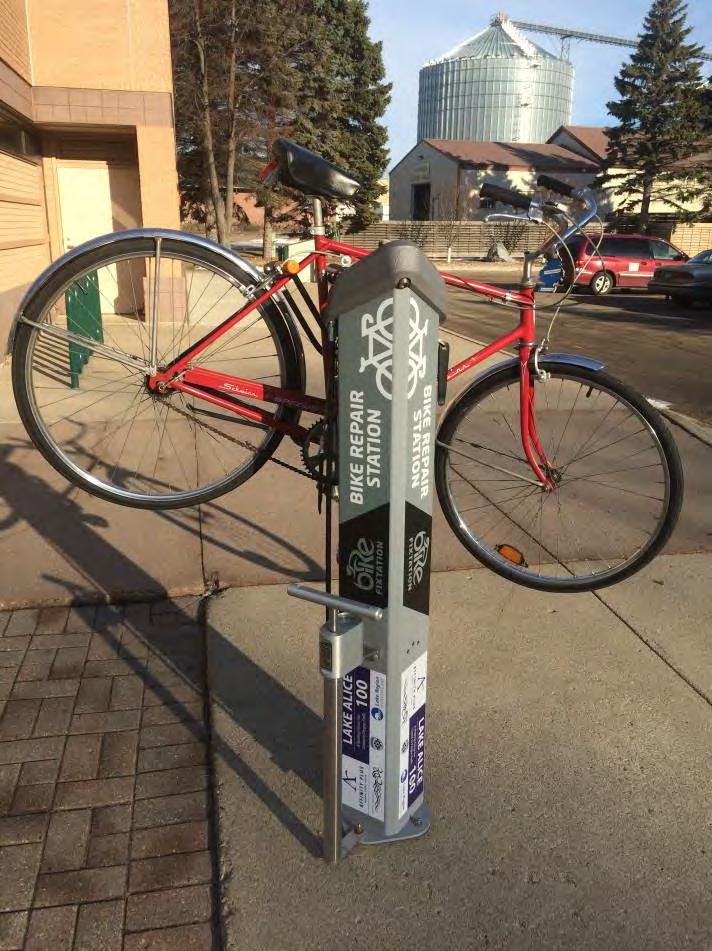
Figure 5: A bicycle repair station with a heavy-duty allweather pump, installed in the Summer of 2015 at the Fergus Falls Public Library.
7. Investigate the feasibility of a walking school bus for students within New York Mills city limits.
A walking school bus is a group of students walking to and from school with chaperones (usually adult / parent volunteers). A walking school bus is a fun, healthy and an easy opportunity for students to be physically active. A walking school bus usually provides front door pick-up and drop-off of students along the way, which can allay most parents’ fears. It can be done daily or just on certain days of the week and/or depending on weather conditions. The New York Mills Elementary School should investigate the desire for a walking school bus and see if parents or other citizen volunteers are interested in taking turns walking students. If a walking school bus is explored, outreach to parents could be done via the parent newsletter. The hardest part to operating a walking school bus is finding enough dedicated volunteers to act as “drivers” but active elderly members of the community have been recruited to perform this task in other towns and cities with very successful results.
P a g e 18 | Executive Summary, Significant Findings And Action Plan
For more Encouragement ideas, see Minnesota SRTS Model Policies Tip Sheet (Appendix E) and the Minnesota SRTS Resource Center – Encouragement: http://www.dot.state.mn.us/mnsaferoutes/resources/encouragement.html .
ENFORCEMENT
Goal: Address traffic and safety concerns by identifying and implementing enforcement measures within the school walk and bike zone.
1. Increase the prevalence of traffic law enforcement in strategic locations during students’ morning arrival and afternoon dismissal.
The SRTS Team and one or two parents from the Parent Survey noted speeding traffic, particularly amongst the high school students, as a barrier for their children to walk and/or bike to school. Increasing the prevalence of law enforcement officers near the school may help to reduce vehicle speeds, improve compliance with speed limits around the school and increase the likelihood of vehicles yielding to pedestrians. This is a short-term, easy-to-implement recommendation that can be low cost.
2. If not done so already, employ a trained adult crossing guard at the corner of Gilman Street and Hayes Avenue in coordination with Engineering suggestions #2, #3 and #4 (Figures 7, 8 and 9) at a location in front of the New York Mills Elementary School.
The presence of a trained adult crossing guard can be of invaluable importance to student safety at locations with busy and/or fast moving traffic like near the elementary front entrance. They often also act as a second pair of much more experienced eyes and can see hazards that young children may not be aware. Also crossing guards can help with the traffic flow of parents picking up and dropping off students and enforce the no parking restrictions in front of the school which was a noted violation by the SRTS Team and during Observation Day. Adult crossing guards have the added benefit of acting as a source of encouragement to students and reassurance to parents. This person could be a school employee, a new hire, or an adult volunteer.
3. If not done so already, investigate restricting high school student drivers to entering and exiting school grounds at the Miller Street entrance via Broadway Avenue , not Walker (See
Engineering suggestion #3 and Figures 8 and 9).
Executive Summary, Significant Findings And Action Plan | P a g e 19
Some teenage drivers are not known for exhibiting the best judgment. With this in mind, it is best to try and remove the traffic they generate from Gilman Street with all of its pedestrian s and parent drop-off and pick-up traffic.
4. If not done so already, investigate rescinding parking privileges to high school students observed driving in an irresponsible manner while arriving and leaving the school grounds. If possible, extend such restrictions to any student who receives any traffic citation and is found guilty of a moving violation.
Being able to drive a private automobile to school and park it on school property is a privilege. Irresponsible driving behaviors by students near the school and around New York Mills should not be tolerated as the consequences can easily be fatal. Several parents of younger students noted the driving behaviors of high school students as a deterrent to allowing their children to walk and/or bike to and from school.
5. Identify the most effective form of automated speed feedback sign and investigate the possible installation (permanent or temporary) at strategic locations within New York
Mills.
While frequently noted as a problem, the SRTS Team observations and community input did not end up identifying one or more particular locations where speeding was a noticeable problem within or near city limits. Speed feedback signs are a fairly uncontroversial and effective means of slowing down traffic and have been used in numerous communities through Greater and west central Minnesota. Using radar to detect a vehicle speed, these signs will display the speed of the oncoming vehicle to remind the driver of their speed if driving above the posted speed limit. If driving more than five mph over the limit the sign can be programmed to flash the detected speed, sometimes with a flashing light to really catch the driver’s attention. It is recommended that the City of New York Mills, with help of county and MnDOT officials, identify the most effective form of automated speed feedback and possible locations for deployment.
For more Enforcement ideas, see Minnesota SRTS Model Policies Tip Sheet (Appendix E) and the Minnesota SRTS Resource Center – Enforcement:
http://www.dot.state.mn.us/mnsaferoutes/resources/enforcement.html .
P a g e 20 | Executive Summary, Significant Findings And Action Plan
ENGINEERING
Goal: Improve the existing infrastructure within the community to ensure active transportation is encouraged and made safe.
Note – All of the following recommended proposals are rough but well thought-out ideas from a professional active transportation planner. They will need further vetting and refinement, including that of a licensed engineer, to see if they are feasible. The recommendations below are listed in a general order of priority. For a visual summary of the suggested Engineering proposals, please see Figures 6 - 11.
1. With the following engineering suggestions, ensure that all meet conventional standards including but not limited to the latest Public Right-of-Way Accessibility Guidelines (PROWAG) for ADA compliance and the AASHTO Guide for the Development of Bicycle
Facilities. For more information regarding ADA PROWAG guidelines in Minnesota, please see MnDOT’s Curb Ramp Guidelines from October 2010.
2. Install sidewalks and crosswalks near the school per Figure 7 to aid students walking and biking to school. Be aware of the recommended sidewalk widths which are advised to handle the extra pedestrian traffic of walking students near the school and gathering in groups, along with children being dropped off on Gilman Street.
3. Investigate closing the drop-off loop directly in front of the school and Gilman Street west of Hayes Avenue to all traffic during morning arrival and afternoon dismissal (see Figure 7). This is proposed in order to create a more orderly traffic flow, reduce automobile/pedestrian conflict zones at crosswalks near the school and to help make it safer for children as they gather and depart near the elementary school entrance.
4. In coordination with the suggested sidewalk, crosswalk and road closure recommendations, investigate the implementation of the suggested morning drop-off and afternoon pick-up circulation plans complete with parking restrictions (see Figures 8 and 9).
5. Post 10 mph speed limit signs at the points where Hayes Avenue and Miller Street cross onto school property. The speed limit on school property should be clearly marked at 10 mph.
Executive Summary, Significant Findings And Action Plan | P a g e 21
6. Investigate “School Zone” speed limit of 15 mph on Gilman Street in front of the school to
Walker Avenue, Hayes Avenue from a point 300 feet south of Gilman, and on Miller Street from a point immediately west of the Mills Car Wash.
7. Investigate reconstructing Miller Street with curb and gutter, a south side sidewalk, and well-engineered, marked crosswalks that follow logical desire lines to shopping destinations on the north that are commonly frequented by students after school.
8. Investigate the reconstruction of the high school parking lot so that the sidewalk from the south side of Miller Street at Walker Avenue to the front entrance of the high school follows a more logical and direct desire line. Also ensure that this new sidewalk lines up well with the proposed sidewalk on the south side of Miller Street and has landscape protections to make it an inviting route, as well as protecting the pedestrian space from possible intruding parked cars (see Figure 7).
9. Investigate reducing the width of Hayes Avenue just west of the school building (currently 48 feet curb to curb not including parking) and widen the sidewalk in this area. Hayes
Avenue north of Gilman Street has been vacated by the city and is now a part of school property. As such, Hayes Avenue no longer needs to be this wide and can be made narrower to accommodate a sidewalk of proper width in front of the school that also includes a boulevard buffer from parked cars (see Figure 7).
10. Coordinate with MnDOT and Otter Tail County regarding the construction of a multi-use pathway along Broadway Avenue (County 67) through the U.S. Highway 10 interchange from Gilman Street in the south to Mockingbird Lane or County Highway 56 to the north (see Figure 10). Preliminary investigation by WCI staff suggests that routing this path on the east side of Broadway Avenue may be preferable due to the available ROW space and the lower number of roadway and driveway conflicts. It is recommended that the best contemporary bicycle and pedestrian safety countermeasures be employed to ensure the maximum safety of both bicyclists and pedestrians at both highway ramp crossings and the street crossings at Carlund Parkway and Mocking Bird Lane.
P a g e 22 | Executive Summary, Significant Findings And Action Plan
11. Rehabilitate and install new sidewalk per the recommendations in Figure 10 and PROWAG.
Start with sidewalks closest to the school like Gilman, Miller Street and Hayes Avenue, generally working outward with a secondary focus on busier streets like Broadway and those with a greater number residences and on roadways that connect to neighborhoods.
Coordinate sidewalk installations with other road / infrastructure projects, to take advantage of potential cost savings. Use best local and engineering judgment when prioritizing installations.
12. Where practicable, set sidewalks as far back as possible from the roadway curb to create a buffer between pedestrians and motor vehicle traffic. Such buffers can reduce traffic stress on pedestrians and make walking safer and more enjoyable, while providing a place for street trees to grow. These buffers are even more important on busier roadways with higher traffic volumes, faster vehicle speeds, and/or significant heavy truck traffic.
13. Investigate traffic calming measures on streets not intended for through-traffic such as
Cornwell, Gilman, Parke (east of Broadway), Smith and Lund, as well as streets south of the railroad and east of Main Avenue and far South Walker, which is outside of city limits. This is especially important on streets where sidewalks are not recommended due to their very low traffic volumes, narrow nature, dispersed residences and/or distance from the school.
14. Work with MnDOT and even the State Legislature on the posting of 20 mph speed limits. It is suggested that all streets within New York Mills that are not a part of the state and county networks be posted at 20 mph. Many are already posted as such within the city.
Lowering traffic speeds is a solidly-proven traffic safety countermeasure and lowering the speed limits can be done rather inexpensively. Nearly all of the roads that fall under this recommendation are residential in nature and have limited potential to well serve through-traffic.
15. Investigate installing sidewalk bump-outs at select intersections in downtown, namely on
Centennial 84 Drive and Main Avenue. Bump-outs have a traffic calming effect, reduce the distance that pedestrians are in the street with automobiles, can prevent illegal parking of vehicles too close to a crosswalk and/or stop sign, which can block a driver’s view of these traffic control devices. They aid in making pedestrians and stop signs more visible to drivers by placing them in a more conspicuous, easier to be seen location, without being in the roadway. Sidewalk bump-outs can be engineered to be mountable when large heavy trucks need to turn at bump-out intersections.
Executive Summary, Significant Findings And Action Plan | P a g e 23
16. Investigate reducing the width of Centennial 84 Drive between Hayes and Broadway
Avenues (currently 54 to 70 feet) to reduce pedestrian crossing distances and to add a traffic calming effect. For a measure of comparison, U.S. Highway 10 in Wadena, with two shoulders and three traffic lanes, is only 48 feet wide curb to curb. This reduction can be done while keeping a practical amount of on-street parking and maintaining operating room for larger heavy trucks and farm equipment. An on-street bike lane could also have a road width reducing effect while providing guidance on proper lane placement and encouragement for those who may choose to ride a bicycle to school. At the same time, when safe to do so, the bicycle lane can be encroached upon during the infrequent times required by the driver of a larger vehicle to navigate the street. It should be noted that there was a crash involving a 66-year-old pedestrian that caused possible injuries that occurred at the intersection of Centennial 84 Drive and Main Avenue on June 1, 2011 at 09:03 hours. The driver was found to be at
fault for failing to yield to the pedestrian. It is possible that proven pedestrian safety countermeasures, such as roadway width reduction and bump-outs suggested in #16, may have prevented this crash.
17. Coordinate with MnDOT, BNSF
Railroad and Otter Tail County, regarding the possible reconstruction of the Main Avenue South (County 67) at-grade railroad crossing to assure that both sidewalks meet the latest
PROWAG ADA standards. It is also
suggested that barrier gates be installed at all four sidewalk access
points to physically prevent pedestrians from encroaching into and crossing the railroad right-of-way when trains are present or approaching (see Figures 6 and 11).
Figure 6: Tactile strips, lights, bells and gates to block pedestrian and bicycle traffic along with smooth and robust precast concrete panels filling the gaps between and around the railroad tracks make this crossing in Fergus Falls about as safe and ADA compliant as one can be for pedestrians and bicyclists in all of west central Minnesota.
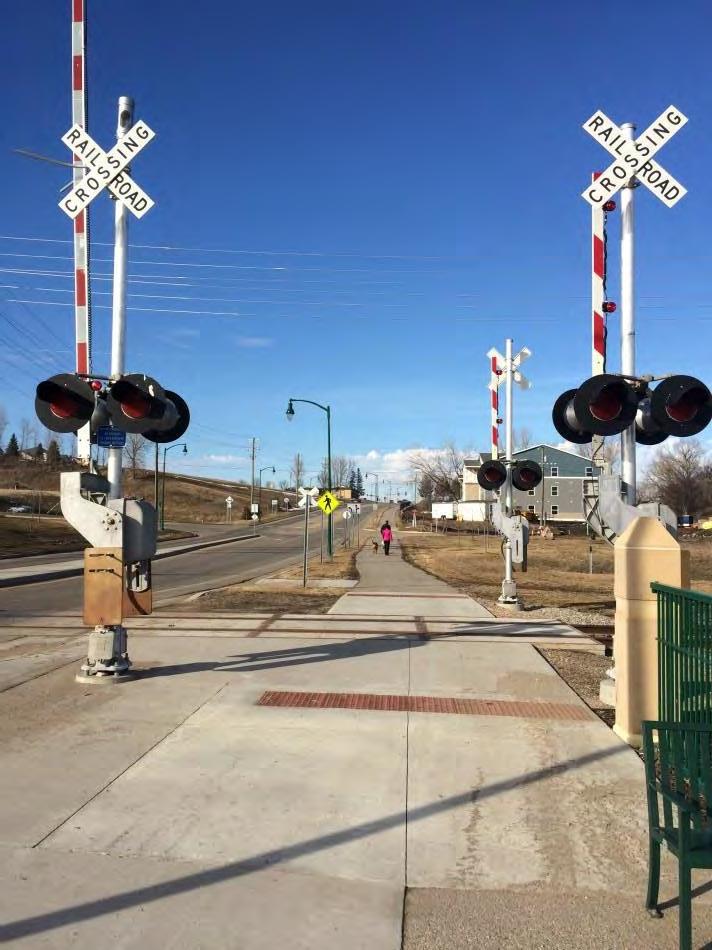
P a g e 24 | Executive Summary, Significant Findings And Action Plan
18. Coordinate and investigate with BNSF Railroad and MnDOT regarding the installation of a single, PROWAG ADA-compliant pedestrian crossing of the railroad on the west side of
Walker Avenue. It is also suggested that barrier gates be installed at both sidewalk access points to physically prevent pedestrians from encroaching into and crossing the railroad right-of-way when trains are present or approaching (see Figures 6 and 11).
19. Coordinate and investigate with BNSF Railroad and MnDOT regarding the installation of fencing on the south side of the railroad from Boardman Avenue in the west to a point several hundred feet to the east of the South Broadway Avenue ROW, and on the north side from point approximately 500 feet to the west of Walker Avenue (likely located between the main line and the railroad siding) to a location approximately 2500 feet east of Main
Ave (approximately 300 feet east of Mills Lanes & Lucky Strike). This can help to prevent pedestrian trespass on the railroad right-of-way and focus pedestrians to legal crossing locations with proper warning beacons and gates (see Figure 11).
For more Engineering ideas see Minnesota SRTS Model Policies Tip Sheet (Appendix E) and the Minnesota SRTS Resource Center – Engineering: http://www.dot.state.mn.us/mnsaferoutes/resources/engineering.html .
Executive Summary, Significant Findings And Action Plan | P a g e 25
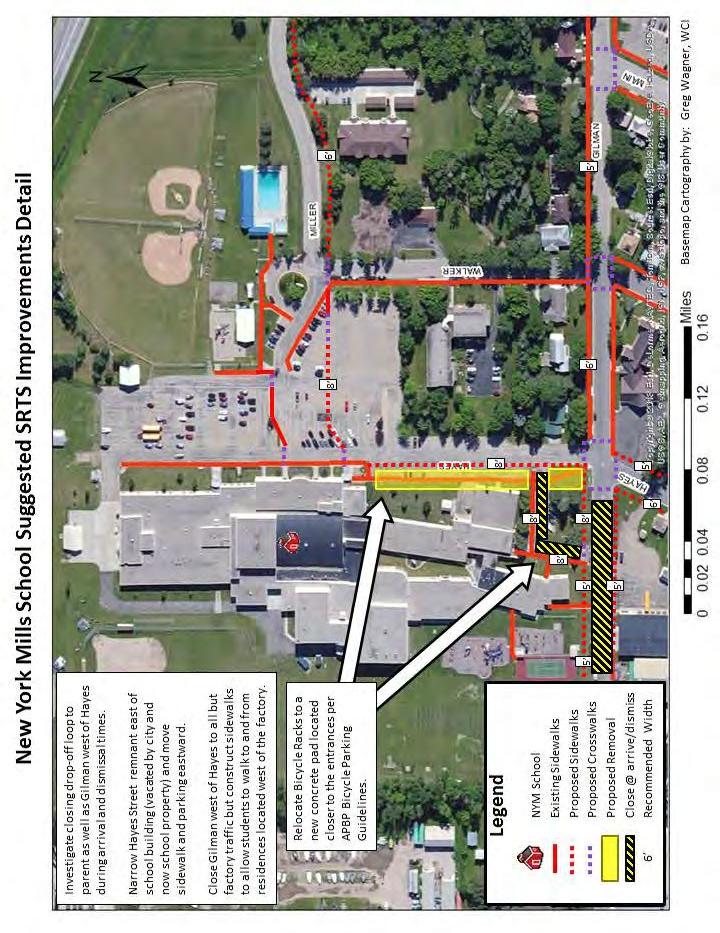
Figure 7: New York Mills School Suggested SRTS Improvements Detail.
P a g e 26 | Executive Summary, Significant Findings And Action Plan
New York Mills School Suggested SRTS Morning Circulation (Figure 8) All closure lines and no parking areas are intended to be temporary; just for arrival and departure and affect only parents and students, not local residents, teachers or school bus drivers. Lund factory employees and delivery drivers will be discouraged from using Gilman in front of the school during morning arrival.
An adult crossing guard will be assigned to Hayes and Gilman to assist students walking and biking to school at this busy intersection.
To avoid additional traffic congestion at the corner of Hayes and Gilman, all high school students who drive must arrive via Miller from Broadway and not Walker.
New York Mills School Suggested SRTS Afternoon Circulation (Figure 9) All closure lines are intended to be temporary; just for arrival and departure and affect only parents and students, not local residents, teachers or school bus drivers. Lund factory employees and delivery drivers will be discouraged from using Gilman in front of the school during afternoon departure.
To avoid heavy traffic conditions at time of departure, students walking or biking home to the south and east will not be allowed to cross Gilman at Hayes. An adult crossing guard will guide students to walk on the north side of Gilman east to cross at Walker or Main where traffic from parents picking up students will be lighter. Only students getting picked up by parents on the west side of Hayes will be allowed to cross Gilman. A second crossing guard may be assigned to Walker.
To avoid additional traffic congestion at the corner of Hayes and Gilman, all high school students who drive must depart via Miller to Broadway and not Walker.
Executive Summary, Significant Findings And Action Plan | P a g e 27
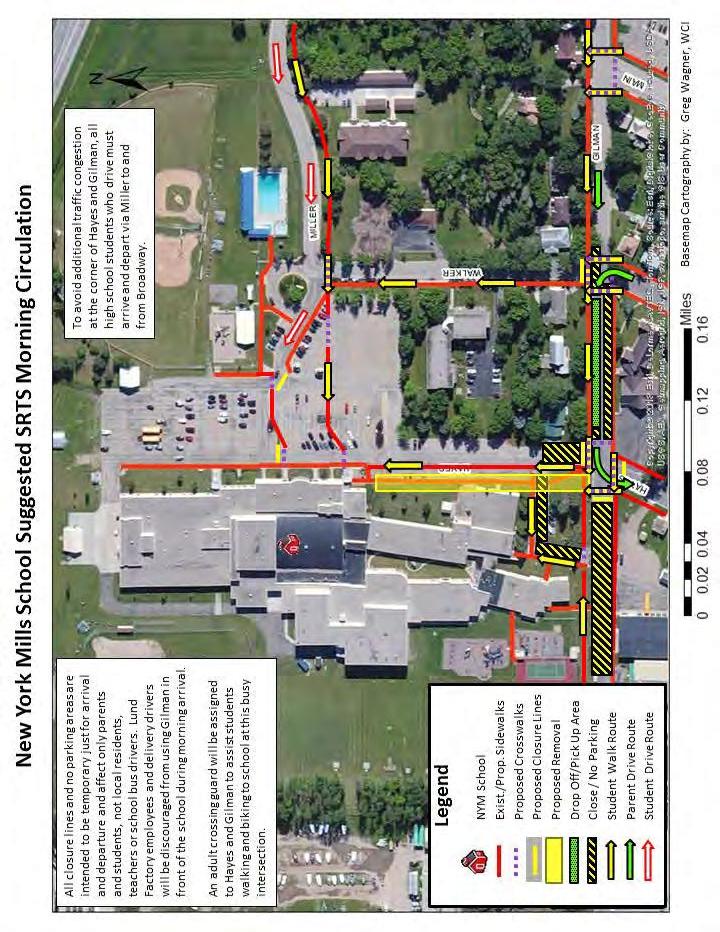
Figure 8: New York Mills School Suggested SRTS Morning Circulation.
P a g e 28 | Executive Summary, Significant Findings And Action Plan
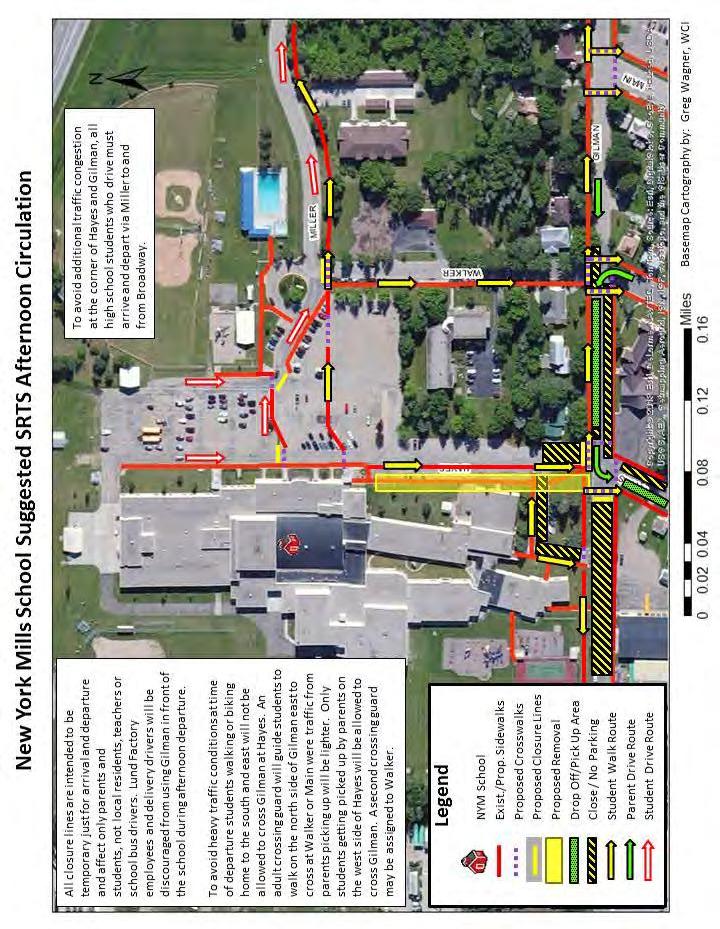
Figure 9: New York Mills School Suggested SRTS Afternoon Circulation.
Executive Summary, Significant Findings And Action Plan | P a g e 29
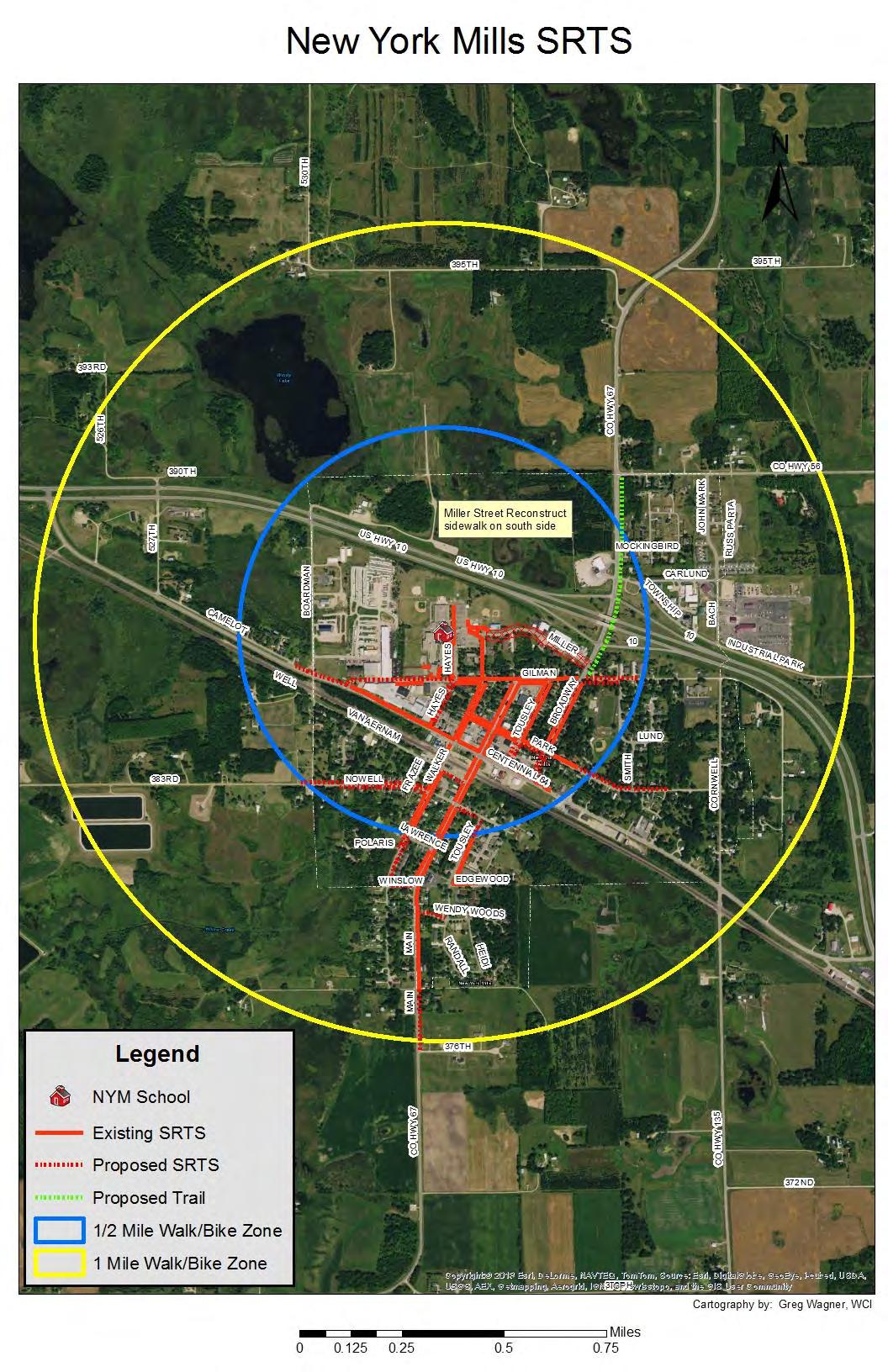
Figure 10: New York Mills Safe Routes to School proposed engineering walking and biking facility improvements.
P a g e 30 | Executive Summary, Significant Findings And Action Plan
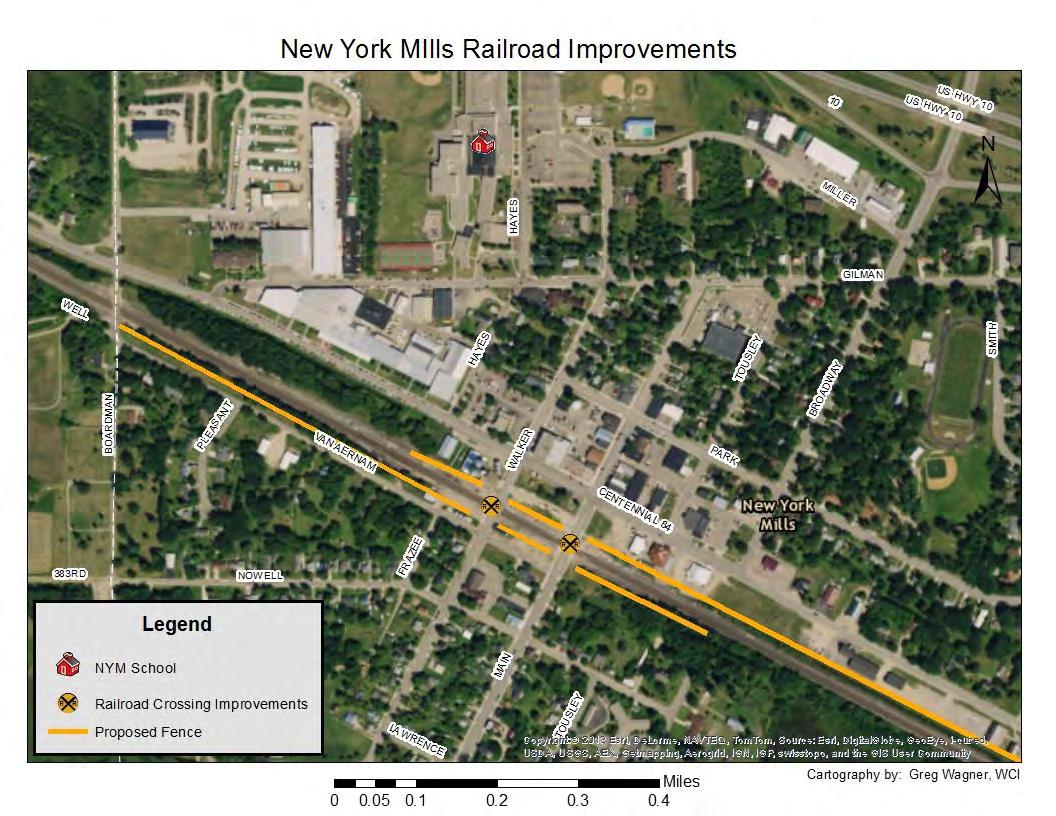
Figure 11: New York Mills proposed bicycle and pedestrian railroad safety improvements.
Executive Summary, Significant Findings And Action Plan | P a g e 31
EVALUATION
Goal: Evaluate the effectiveness of programming by tracking baseline data and, in addition, actively work on improvement, based on results.
1. Administer the student travel tallies at least once per year to track the number of students walking and bicycling in comparison to the 2017 baseline results.
In order to track the results of implemented programming, it is recommended that the New York Mills Elementary School and the New York Mills School District administer the student travel tallies at least annually. The results will indicate the number of students walking and bicycling, which in turn will identify the effectiveness of programs. If possible, try to conduct the student travel tallies more than once per year so it is possible to capture travel data during periods of inclement weather, particularly rain and snow, to see how that affects student travel mode choice. This data will also be useful when applying for non-infrastructure or infrastructure funding.
2. Administer a parent survey questionnaire once every two to three years to track and analyze school travel behaviors and parents’ perceptions in comparison to the 2014 baseline results.
The parent survey tool tracks and analyzes student travel behaviors and parents’ perceptions of walking and bicycling. This survey should be conducted no more than biannually as attitudes are not likely to change that quickly. If done too frequently, parents may not be as inclined to fill them out.
3. Explore establishing baseline health data (possibly already gathered) to evaluate possible health improvements over time related to SRTS improvements.
In order to track student health improvements over time, it is suggested that the New York Mills School District collect baseline health data. It is likely that the school district is already collecting this data. As SRTS programs and improvements are implemented, the health of students can be tracked on a continual basis. PartnerSHIP 4 Health may be able to help the school district organize this.
For more Evaluation ideas see Minnesota SRTS Model Policies Tip Sheet (Appendix E) and the Minnesota SRTS Resource Center – Evaluation:
http://www.dot.state.mn.us/mnsaferoutes/resources/evaluation.html .
P a g e 32 | Executive Summary, Significant Findings And Action Plan
OTHER
Goal: Eliminate conflicts with high school student drivers who have been observed driving inappropriately at afternoon dismissal times.
1. Maintain the later dismissal times for high school students so the high school-aged drivers are not leaving at the same time as the younger elementary school students.
While not observed by the SRTS Team during Observation Day, aggressive driving was observed at dismissal by the author when he was in New York Mills in the Spring of 2016. It likely benefits student safety by having the elementary school students dismiss several minutes before the high school students so the younger students can clear the area around the school before the high school drivers leave. Since the buses must wait for the high school students to dismiss this also eliminates bus traffic from around the school and nearby streets when elementary school students are walking home.
Goal: Create partnerships with local businesses and organizations to increase support and encouragement of active transportation.
2. Identify opportunities or partners to fund bicycle helmets for educational events like bike rodeos and/or Walk! Bike! Fun! training events.
Goal: Work to ensure all City policies and ordinances are supportive of active transportation.
3. If not done so already, the city should create an ordinance that mandates the preservation of sidewalks installed within the public right-of-way. This ordinance should include maintenance and clearance of those sidewalks by adjacent property owners during snow and other weather events.
4. Investigate a policy that ensure that existing sidewalks are properly cleared of snow within 24 hours and identify snow storage areas that do not impede walking and bicycling to school. This is particularly important at the corners of intersections.
Executive Summary, Significant Findings And Action Plan | P a g e 33





